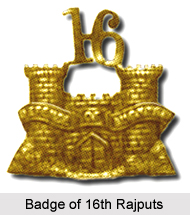 The 16th (The Lucknow) Bengal Native Infantry was a former infantry regiment of the Army of Bengal Presidency till 1895. The battalion was formed in the year 1857 during the Sepoy Mutiny and served till 1922. The unit operated as a division of the Bengal Native Infantry under the Bengal Army, which was one of the main Presidency Armies in British India. The 16th Bengal Native Infantry also served as a part of the Bengal Command. Initially, the Bengal Army was managed by the British East India Company, but after the Great Revolt and the authorization of the Government of India Act 1858, the Bengal Native Infantry was administered by the British Empire in India. It became a part of the United British Indian Army in 1903. In the same year, the army unit was named as the 16th Rajputs (The Lucknow Regiment) after the reforms in the British Indian Army by Lord Kitchener.
The 16th (The Lucknow) Bengal Native Infantry was a former infantry regiment of the Army of Bengal Presidency till 1895. The battalion was formed in the year 1857 during the Sepoy Mutiny and served till 1922. The unit operated as a division of the Bengal Native Infantry under the Bengal Army, which was one of the main Presidency Armies in British India. The 16th Bengal Native Infantry also served as a part of the Bengal Command. Initially, the Bengal Army was managed by the British East India Company, but after the Great Revolt and the authorization of the Government of India Act 1858, the Bengal Native Infantry was administered by the British Empire in India. It became a part of the United British Indian Army in 1903. In the same year, the army unit was named as the 16th Rajputs (The Lucknow Regiment) after the reforms in the British Indian Army by Lord Kitchener.
History of 16th (The Lucknow) Bengal Native Infantry
The 16th (The Lucknow) Bengal Native Infantry was raised by the Honourable British East India Company in 1857. The unit was created by joining the troops of the 13th Bengal Native Infantry, 48th Bengal Native Infantry and 71st Bengal Native Infantry regiment which maintained their loyalty towards the British authorities during the rebellion. It was later designated as The Lucknow Regiment and was tasked with the duty for guarding the Bailey Gate in the Lucknow Residency. Later in 1901, it was renamed as the 16th Rajput Infantry (The Lucknow Regiment).
Military Operations of 16th (The Lucknow) Bengal Native Infantry
The regiment was created for the purpose of providing military support to the East India Company during the Sepoy Mutiny. Later the troops of the unit participated in several British campaigns and battles such as the First Anglo Sikh War, the Second Afghan War, the Siege of Malakand, the Duffla Hill Expedition, the Campaign against Bunerwals and the Third Anglo Burmese War.
The 16th (The Lucknow) Bengal Native Infantry also served during the First World War and took part in the Mesopotamia Campaign. It was attached to the Jubbulpore Brigade 5th (Mhow) Division.
Development of 16th (The Lucknow) Bengal Native Infantry
After the First World War, the British Indian Government re-numbered and re-grouped the regiments in 1922. The single infantry regiments were amalgamated to create larger multi battalion infantry units of 4 to 6 battalions. As a consequence, the 16th (The Lucknow) Bengal Native Infantry regiment was designated as the 10th Training Battalion, 7th Rajput Regiment.
After the withdrawal of the British Empire from India on 15th August 1947, the nation was separated during the Partition of India. Later, the regiments of the British Indian Army were also divided among the 2 new nations, the Union of India and the Dominion of Pakistan. The 16th Rajputs (The Lucknow Regiment) was allocated to the modern Indian Army.
Designations of 16th (The Lucknow) Bengal Native Infantry
The 16th (The Lucknow) Bengal Native Infantry of the British Indian Army occupied a number of designations through out its service. These are mentioned below-
* The Lucknow Regiment in 1857
* 16th Bengal Native Infantry in 1861
* 16th (The Lucknow) Bengal Native Infantry in 1864
* 16th (The Lucknow) Bengal Infantry in 1885
* 16th (The Lucknow) Rajput Bengal Infantry in 1897
* 16th Rajput Infantry (The Lucknow Regiment) in 1901
* 16th Rajputs (The Lucknow Regiment) in 1903
* 10th Training Battalion, 7th Rajput Regiment in 1922



















